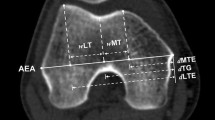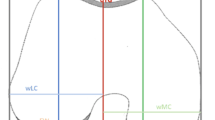Abstract
The aim of the study was to verify the efficacy of ultrasonography (US) in evaluating the morphology of normal trochlea, especially the sulcus angle and the trochlear depth, in comparison with computed tomography (CT) (gold standard). The knees of 11 asymptomatic volunteers were subjected to US and CT evaluation of the same section planes and the results were compared. For statistical evaluation Spearman’s correlation coefficient analysis was used. A statistically significant correlation was found between the two diagnostic procedures (sulcus angle: r = 0.820; trochlear depth: r = 0.802; Spearman’s correlation coefficient) and the intra-observer variability for the US measurements (sulcus angle: r = 0.966; trochlear depth: r = 0.914; Spearman’s correlation coefficient). The mean value of sulcus angle and trochlear depth was 132 ° and 5.6 mm, respectively, similar to those reported in the literature. We conclude that evaluation by US of both sulcus angle and trochlear depth is as reproducible and sensitive as that performed with CT.
Similar content being viewed by others
Author information
Authors and Affiliations
Additional information
Received 22 January 1996; Revision received 11 April 1997; Accepted 22 May 1997
Rights and permissions
About this article
Cite this article
Martino, F., De Serio, A., Macarini, L. et al. Ultrasonography versus computed tomography in evaluation of the femoral trochlear groove morphology: a pilot study on healthy, young volunteers. Eur Radiol 8, 244–247 (1998). https://doi.org/10.1007/s003300050372
Published:
Issue Date:
DOI: https://doi.org/10.1007/s003300050372




